Time is slow in Camiguin.
In a world full of high-rise buildings, bullet trains, and flocks of people rushing from point A to point B – without taking so much as a millisecond to stop and consider what’s around them – Camiguin is the place to escape to it all.
A tropical paradise still untouched by overdevelopment, Camiguin has to be one of my FAVORITE provinces in the country.
And in my Camiguin Travel Guide, I’ll show you the best ways to enjoy the Land Born of Fire.
I’ll go over things like:
- What you need to understand about Camiguin
- How to Get There (including travel requirements)
- A travel map
- Where to stay
- What to do
- Where to eat
- Sample Itineraries (including my not-so-ideal use of time when I was there!)
And answer some of the FAQs travelers have about Camiguin.
Shall we?
Camiguin Travel Facts (Understanding Camiguin)
| Travel Difficulty Rating: | 2 out of 4 (Not overdeveloped yet!) |
| Price Rating: | 1 out of 4 (Perfect for Backpackers) |
| Best For: | Nature Lovers (falls, springs, mountains) Divers (scuba and freedivers) Chill travelers |
Here are some of the things that make Camiguin unique!
Camiguin is a Volcanic Island
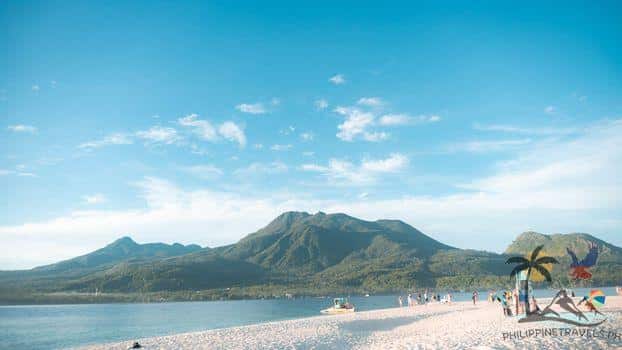
Did you know that Camiguin has more volcanoes than towns?
That’s where the name “The Land Born of Fire” came from!
Aside from the fun facts though, this means two things for the traveler:
- You won’t find a lot of white sand beaches on Camiguin Island
- The island is BURSTING with beautiful nature
That’s right.
The beaches of Camiguin are mostly rocky.
And that’s also why two of its most famous tourist spots are islands off the coast of Camiguin – White Island and Mantigue Island.
Both of these islands have powdery white sand.
But what you will find on the mainland is lush vegetation ALL over the place.
They did a great job of building good roads throughout the island, but everywhere you go you’ll still be surrounded by green!
Camiguin Isn’t Overdeveloped Yet (Hopefully Never!)
You see, there are places like Boracay which are very beautiful – but PACKED with tourists and infrastructure.
Then there are places like, say, Sulu, which are mostly untouched – but also very difficult to get to and potentially dangerous.
Then there’s Camiguin.
The perfect balance between being accommodating enough for tourists, but not so much that it loses its natural charm.
There is a town, there is a mall, there are atms, and there is decent public transportation.
But this mall also closes before sundown, the public transportation is scarce at nighttime, and the town goes to sleep early (there’s very little nightlife here!).
That’s what makes Camiguin so unique in my books.
Time is Slow in Camiguin
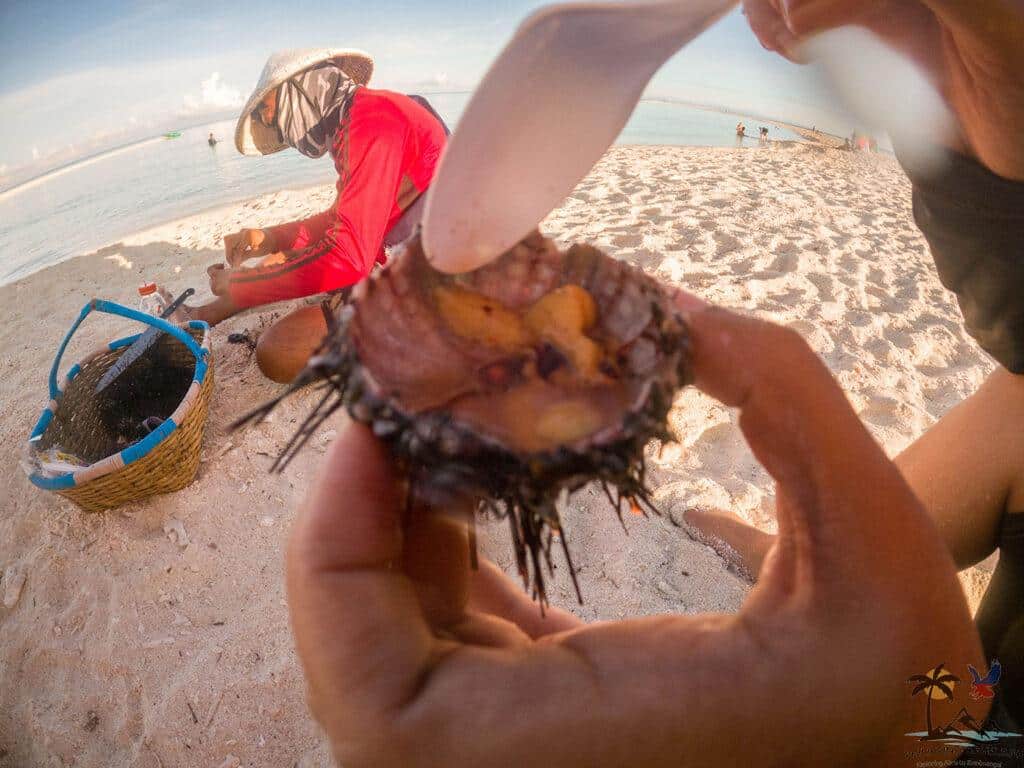
*chik chik chik*
The sound of a man slowwwwwwwwwwwwwwwwwwwwwly chopping away at a small sea urchin.
He was a vendor we met at White Island, and he took a full 5-10 minutes opening 3 small urchins. (not the most efficient for his business, eh?)
But that’s the way it is in Camiguin.
Everything is slower here.
Our motorbike repairman took almost an hour to fix what would be a 10-minute job in Cebu City.
And you can tell who’s not from the island by how fast they drive.
As for the food?
Make sure you don’t come into restaurants starving because that takes a longgggggg time to arrive.
There’s nothing particularly wrong with this attitude of course.
But it might be a bit of a culture shock to you, especially if you’re from a big city!
How to Get to Camiguin
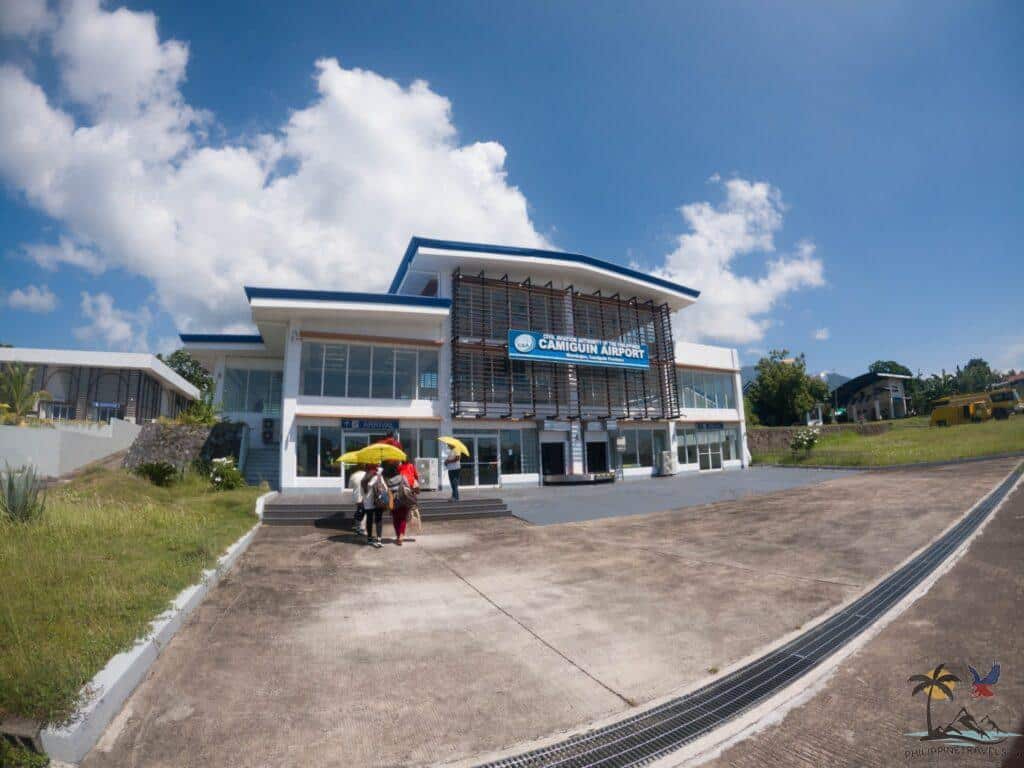
There are THREE main entry points into Camiguin:
- Camiguin Airport in Mambajao, and
- Benoni Port in Mahinog
- Balbagon Port in Mambajao
There are direct flights to Camiguin Airport from Cebu almost every day (thanks to Cebu Pacific).
If you’re coming from Manila, Sunlight Air has a few flights direct from there. However, tickets are quite expensive.
But don’t fret, there are 3 other ways you can get there.
- Fly to Cebu, then take a connecting flight to Camiguin
- Fly to Cagayan de Oro, take a Butuan-bound bus and stop at Balingoan Port. There a ferry leaves for Benoni Port in Camiguin around every hour.
- Fly to Butuan City, take a Cagayan de Oro-bound bus and stop at Baligoan Port. Same thing as #2
Aside from the ferry to Benoni Port, you can also take a fast craft from Baligoan to Guinsiliban.
You can get an updated list of Baligoan and Benoni Port schedules here.
But you get the point.
If you want to get to Camiguin from Manila, you’ll either want to be at Cebu Airport or Baligoan Seaport.
Finally, if you’re coming from Bohol, you can take a ferry from Jagna to Balbabon Port in Mambajao.
The boat leaves 3 times a week. You can find the schedule in the link above, or you can book tickets online through Bookaway or Klook!
Camiguin Travel Requirements
Update! February 2024: You no longer need to be vaccinated to enter Camiguin! You also no longer need a confirmed hotel booking.
The only thing you need now is:
- An Isle Visit Camiguin QR Code (Get yours here!)
The Isle Visit Camiguin QR replaced the previous Clean Camiguin QR codes. The tourism office even plans to implement an online booking system using Isle Visit Camiguin soon!
These are correct as of February 2024. I’ll try to keep this up-to-date, but for the latest information, please check out the Camiguin Tourism Office Facebook page.
Camiguin Travel Map
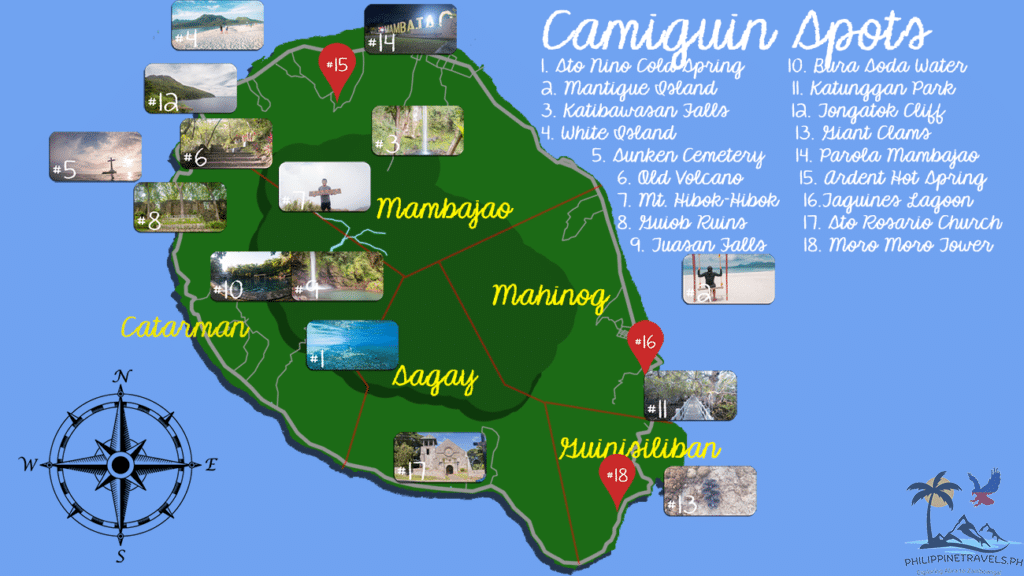
Camiguin is quite a small island. The interior of the island is VERY mountainous, thanks to Camiguin’s volcanoes. While the edges are mostly flat.
The roads here are very well built, making it very easy to drive around the whole island and visit the five municipalities of the island.
Each of these places has something unique to offer. So let’s explore each of them one by one!
Mambajao
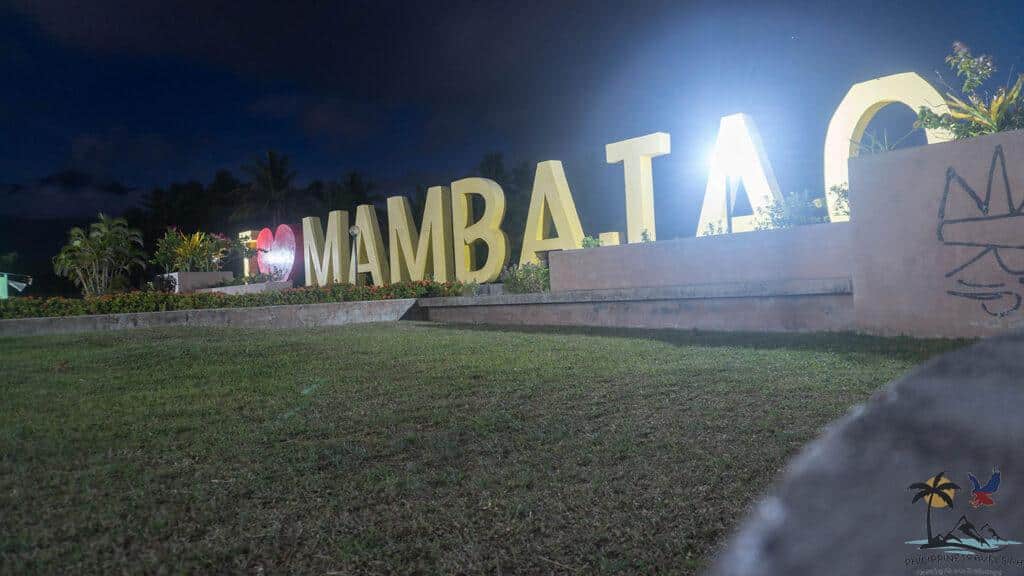
The town. The “center” of the island if you will.
Mambajao is the place you’ll find most establishments on the island.
It’s where you’ll find the airport.
It’s where you’ll find the only ATMs on the island.
It’s where LOTS of the restaurants are (including the only fast-food, Jollibee).
Heck, there’s even a Gaisano shopping mall here!
It’s also the place where public transportation is the most accessible. Orange tricycles go West, while green ones go East!
But despite all of this, it’s still a very slow and peaceful place.
And no matter how long you’re staying, this is probably the best place to be.
Despite being the town center, there are still several tourist spots you can see here, including:
- Parola Mambajao and the 1914 Monument
- Katibawasan Falls
- Ardent Hot Spring
- Mt. Hibok-Hibok (after a 3-5 hour hike)
- White Island (outskirts of Mambajao)
- Tongatok Cliff (outskirts)
Catarman
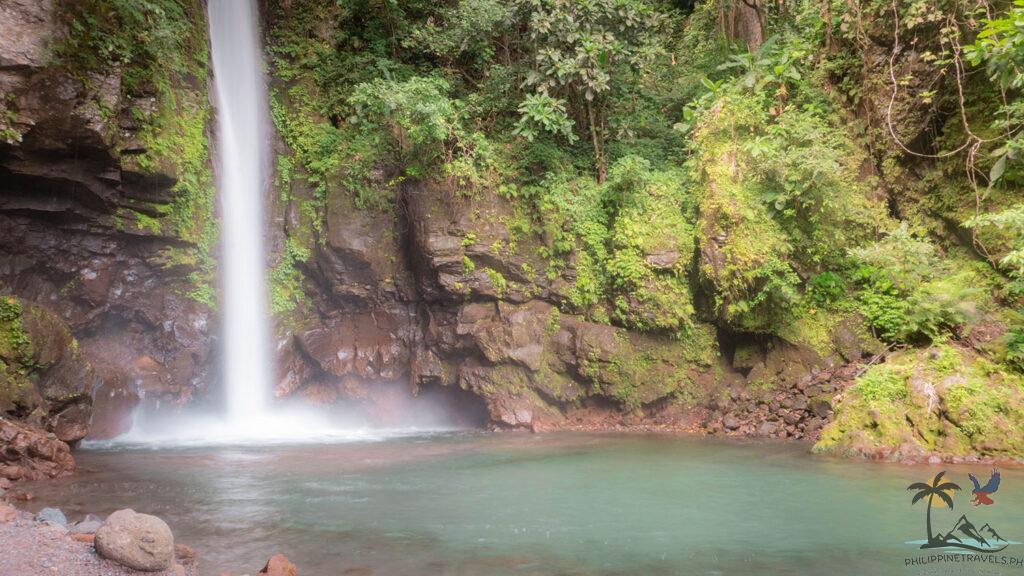
To the east of Mambajao lies Catarman, which I also like to call the “tourist spot zone” of Camiguin!
First off: You can almost consider White Island and Tongatok Cliff as part of Catarman.
They’re actually nearer the tourist spots of Catarman than Mambajao town proper itself.
But aside from those, here are the spots you can check out in Catarman!
- The Walkway to the Old Volcano
- Sunken Cemetery
- Guiob Old Church Ruins
- Tuasan Falls
- Bura Soda Water Park
- Sto. Nino Cold Spring
It might not sound like a lot, but these are 6 of the very best tourist spots in Camiguin.
You’ll also notice that there’s plenty of diversity in that list; everything from a quick hike up the old volcano, to cold springs, to waterfalls, to ruins, to a sunken cemetery!
That’s why Catarman is easily one of my favorite parts of Camiguin.
Sagay

Continuing on our counter-clockwise journey of the island, you’ll get to the most unknown and undeveloped part of the island: Sagay.
There’s literally only one “official” tourist spot here, and that’s the Sto. Rosario church (which, isn’t that impressive either).
However, I’m almost certain there are hidden gems around here. It takes an epic adventurer to go and look for them though!
For those of us who aren’t exactly hardcore, Sagay is just a quite little town you’ll pass through if you decide to ride a motorbike around the whole island (more on this later).
Guinsiliban
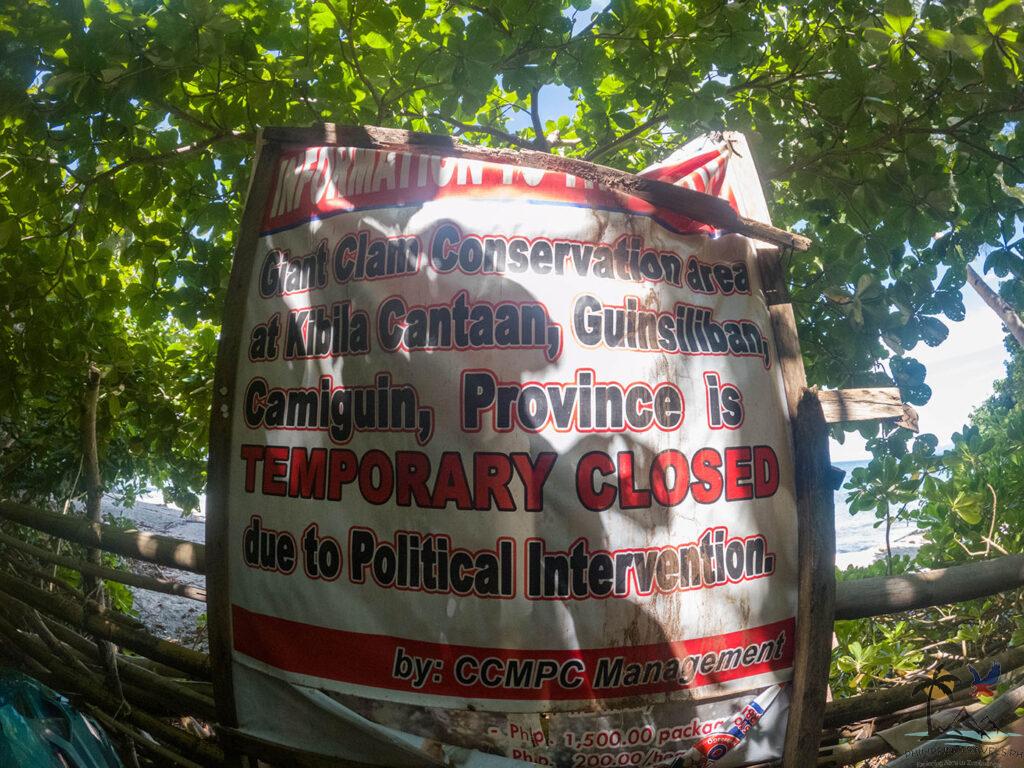
On the south-eastern edge of Camiguin is Guinsiliban.
Much like Sagay, this place isn’t really developed for tourism either.
However, the giant clam sanctuary was actually found here!
That is… before it was shut down by the government (you can read more about this and my thoughts on it in my Camiguin Tourist Spots article!).
As of February 2024, it’s still closed. However, some people have suggested that you can find locals in Guinsiliban who can still show you the giant clams.
But again, since it isn’t an official tourist spot, you’ll have to be a hardcore adventurer to do this!
Aside from that, Guinsiliban also has the also the Moro Watchtower – which is quite difficult to find as its inside school grounds!
Mahinog
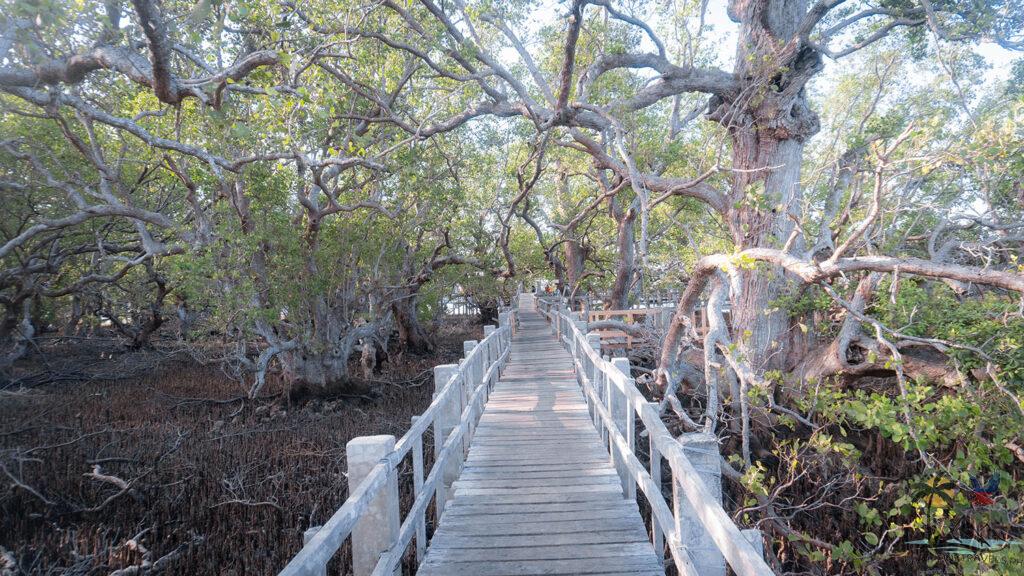
Last but not least Mahinog, the town just East of Mambajao.
This is where Benoni Port is found. So if you’re coming by boat, this is most likely where you’ll dock.
There are a couple of interesting things to see in Mahinog.
Most notably is Mantigue Island – one of my favorite places in the whole Camiguin.
The departure area for Mantigue is only 2km from Benoni Port, making it super easy to get to if you’ve just arrived by boat!
Other than that, there’s also the Taguines Lagoon and Katunggan Mangrove Park here.
Where to Stay in Camiguin
There are a number of good places to stay in Camiguin.
And as of 2024, you no longer need to stay at an LGU-accredited accommodation to enter Camiguin.
This allows you to enter without any booking. So if you’re the type of traveler who likes to make bookings on the spot, this is good news for you.
Here are a few recommendations!
Where to Stay in Camiguin #1: Tongatok Cliff Resort (Cozy Stay Near Tourist Spots)

I didn’t stay here, but part of me wishes I did!
The reason for this is twofold:
- Tongatok is in a VERY good location
- It looks COZY!
Tongatok Cliff is right in between Mambajao and Catarman. This means that if you need something, the town proper won’t be too far away.
And on the other side, you’ll also be VERY close to the most beautiful Camiguin tourist spots too.
Secondly, the Tongatok Cliff Resort looked really relaxing.
We ate in the resort’s restaurant, so we got to see inside a bit – and boy does it look like a place you wouldn’t want to leave!
Where to Stay in Camiguin #2: Bintana sa Paraiso (Popular Luxury Resort)

“Window to Paradise”.
Again, I didn’t stay here, but all the while I was in Camiguin, this name kept coming up.
Apparently, it’s one of the most popular resorts in the island, and looking at the pictures, I can see why.
For a moderate price range of 2,000 – 6,000php ($40 – $120), you can enjoy a pretty luxurious stay at Camiguin!
And again, these guys didn’t pay me to say this, but it certainly looks like a great place to stay! Plus, it’s located quite close to Mambajao town too.
Note: There are 2 branches of Bintana sa Paraiso in Camiguin. One is in the mountains, and the one I saw was by the beach! Both are luxury stays. Check them out below!
Where to Stay in Camiguin #3: Bungalow House (Where I Stayed!)
Me and my two sisters stayed at Bungalow House, a big, BIG airbnb that could fit up to 20 people on it. Our hostess was shocked that we were just three!
But there were a number of factors why we chose the place, and I can say it did really well!
First, Bungalow House is close to the town.
Second, despite being a little way off the highway, we rented motorbikes, so going out was not a problem at all.
Third, it had fast internet, which we needed since this was a working trip.
And fourth, it’s a great way to escape.
The thing I like about airbnbs is that you feel like you live in the place, that you’re not just a visitor. And that’s exactly how Bungalow House made us feel.
We even had a cow right outside our window!
Where to Stay in Camiguin #4: Kurma Dive Resort (Freediving Resort!)

Wanna try freediving?
Welp! You’re in luck.
Camiguin is one of the most UNDERRATED freediving destinations in the Philippines.
Everyone knows about the sardines in Moalboal, the barracuda in Siquijor, and the strong freediving community in Bohol…
But not many people know about the amazing underwater wonders in Camiguin.
If you’re want to freedive, Kurma is probably the best place to stay.
They run freediving camps every year. My sister joined one, and she says the community and dives there are simply amazing.
Where to Stay in Camiguin #5: Anywhere in Mambajao

Being the center of the island, it’s no surprise that there are LOTS of accommodations in Mambajao.
These range from budget options, all the way to luxury stays. Here are some of your options!
Budget Stays:
- GV Hotel – Cheapest option
- Mikki’s Pension House – Walking distance to airport
- Ziet Hotel – Right in the middle of town
- Cabuan Resort – Budget beach resort in town
Mid to Luxury Stays:
- Marianita’s Cottages – Most popular in Mambajao
- Balai sa Baibai – Highest rated luxury resort
- Lanzones Cabana – Quirky resort with colorful cabana huts
- Mabini Hotel – Best hotel in the middle of town
Again, staying in Mambajao is probably best.
It’s very easy to access the other parts of the island from here. Plus, you’ll have everything you need around here too.
Camiguin Activities (What to do in Camiguin!)
Now for the fun part!
When in Camiguin, you won’t run out of things to do.
Here are some of my favorite ones.
Note: if you want to learn more about these tourist spots including their entrance fees, opening times, etc., check out my Camiguin Tourist Spots post!
What to do in Camiguin #1: Bask in Eternal Sunshine in Camiguin’s White Sand Islands
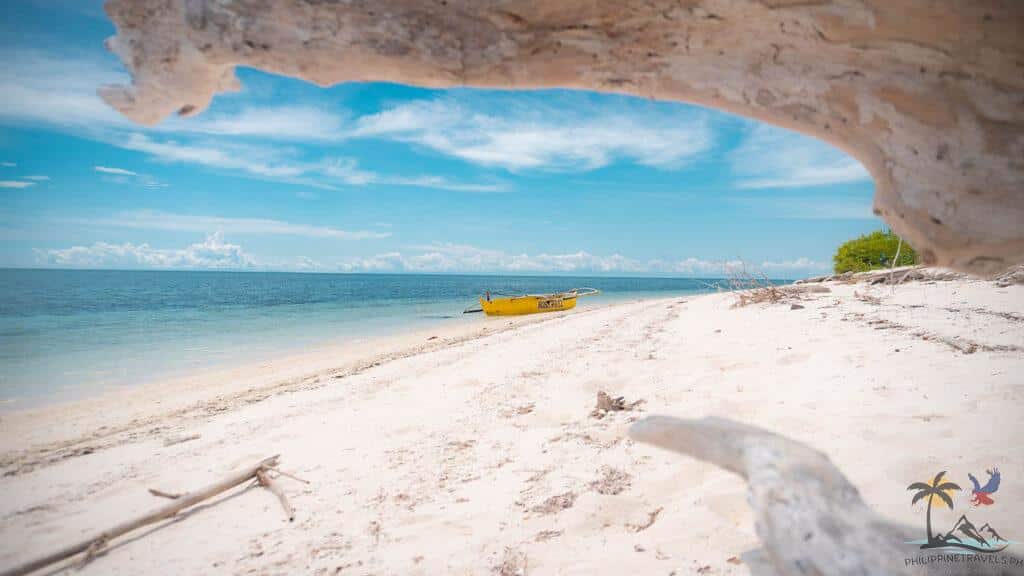
Camiguin island itself does NOT have white sand beaches (or if they do, it’s very unknown).
But just a short pump boat ride away are two extraordinary islands: White Island and Mantigue Island.
Both of these have powdery white sand and breathtaking backdrops of Camiguin island.
As for differences, White Island is a sandbar.
This means that it’s literally just a pile of sand peeping out of the sea.
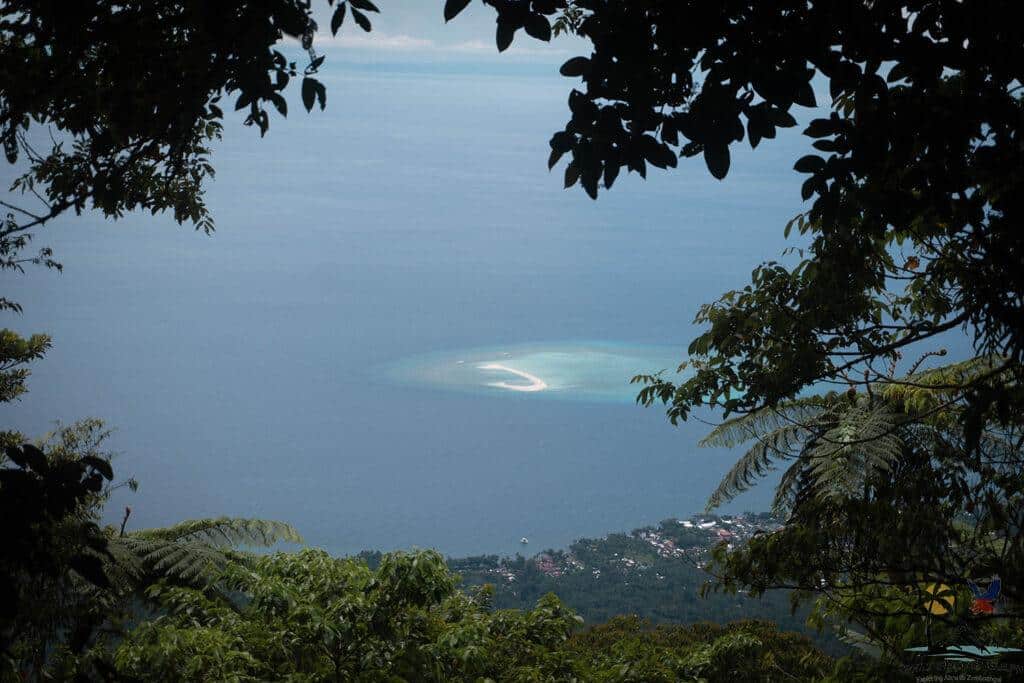
During sunrise and sunset, it’s a very cozy place to take a dip or just relax and gaze at the beauty of Camiguin.
When the sun is up and there’s no cover, you can go sunbathing. They also have umbrellas for rent for those of you who’d rather not get sunburnt!
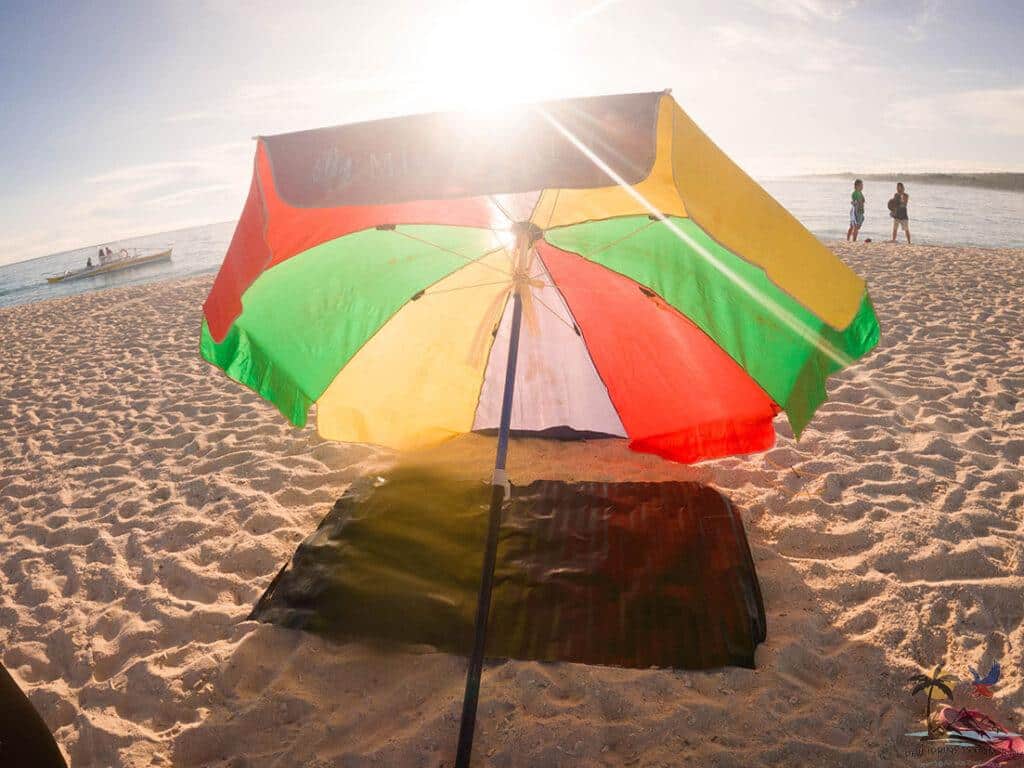
On the other side of Camiguin is Mantigue Island.
Mantigue is bigger and has plenty of trees for cover.
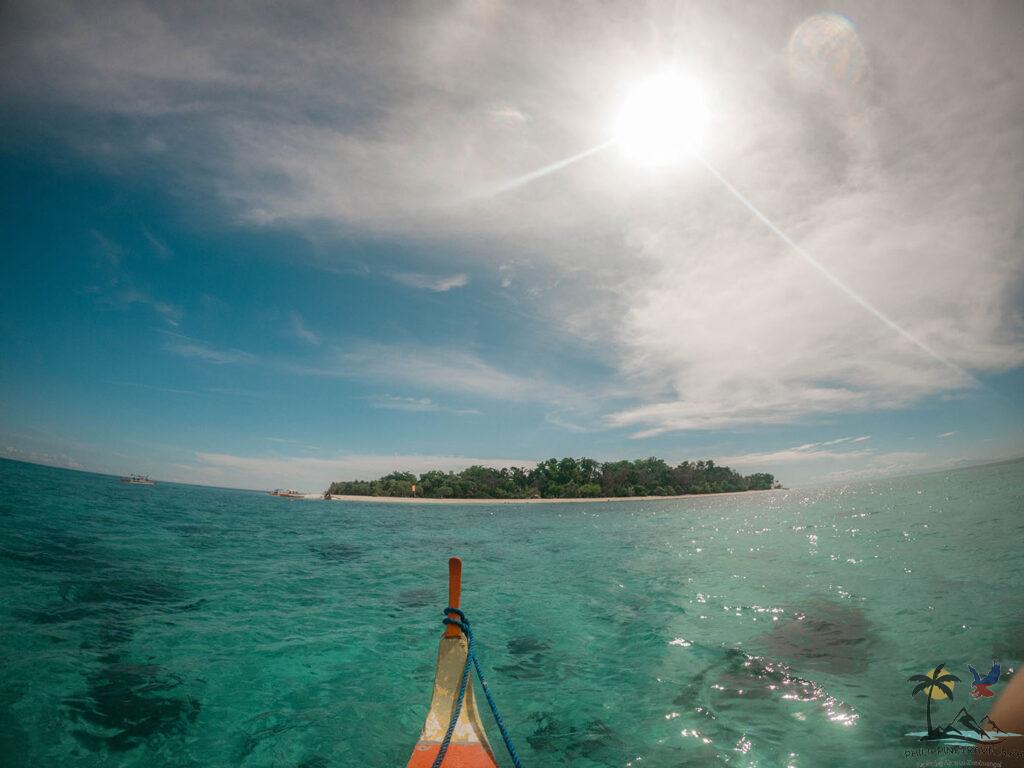
And a few meters off their shore, there’s a sprawling coral reef – one of the best ones I’ve ever seen!
There are all kinds of fish here, and plenty of friendly turtles too!
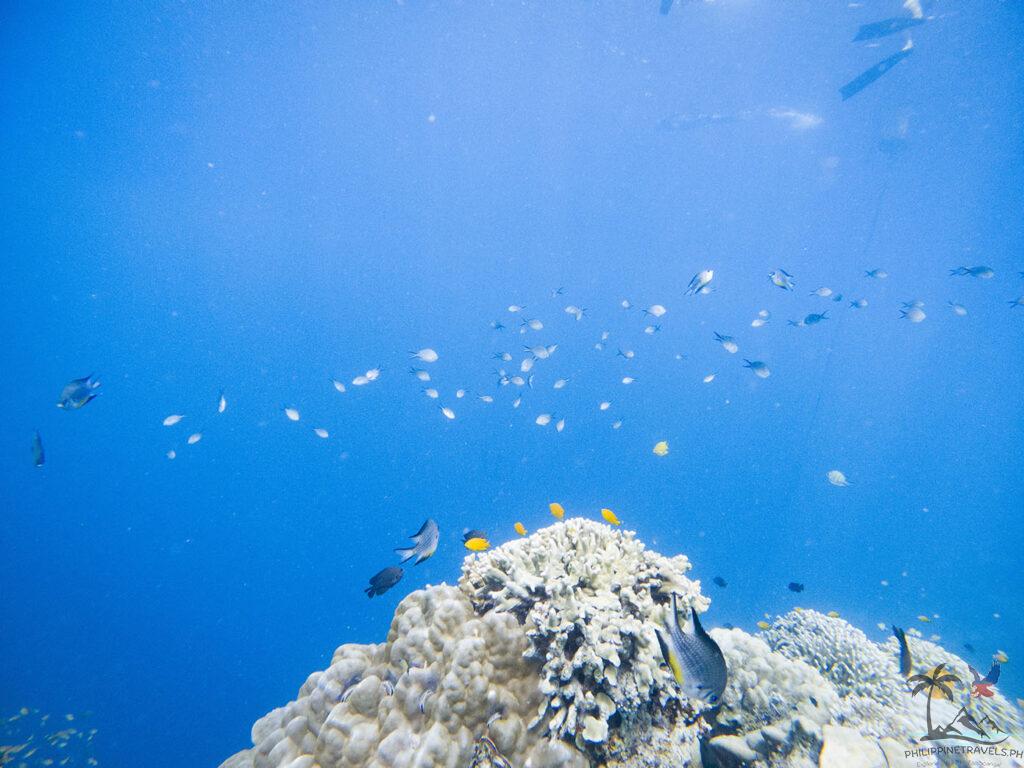
Mantigue was one of the stand-out spots for me. And I’d say, you really shouldn’t miss it!
What to do in Camiguin #2: Follow The Story of Mt. Vulcan’s Eruption
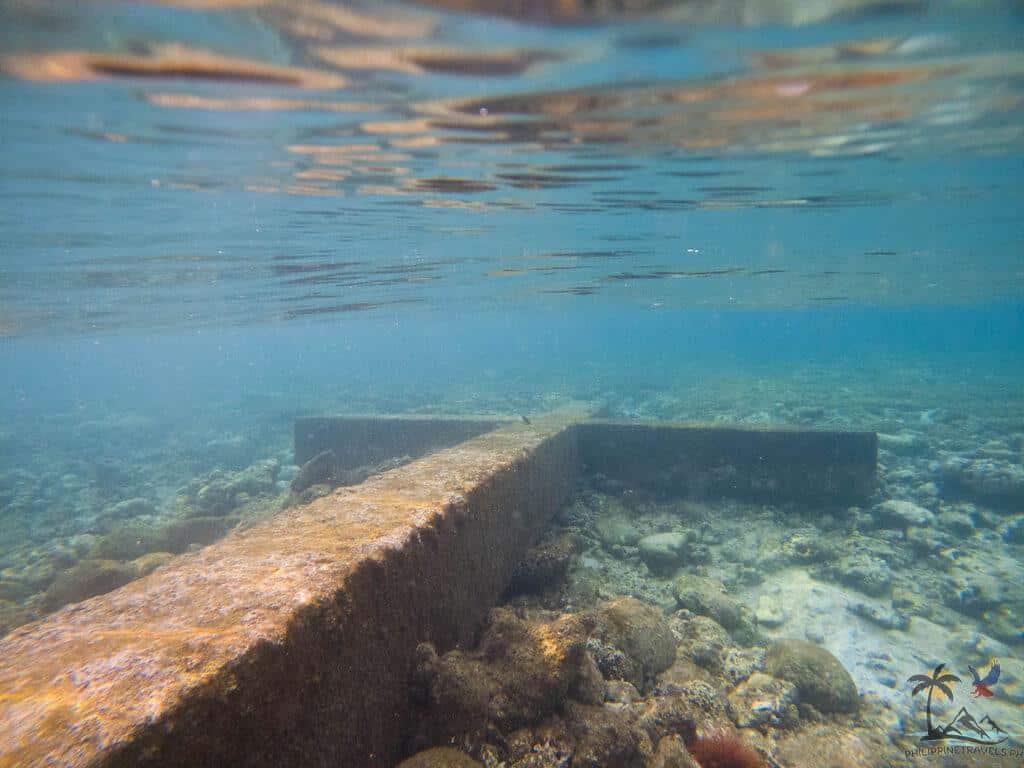
In 1871, Mt. Vulcan (the old volcano) had a massive eruption.
The church nearby was destroyed, and the earthquake was so great, that the ground beneath the Spanish cemetery collapsed into the ocean.
Today, you can visit all three pieces of this story!
Starting with the Old Volcano.
Mt. Vulcan is now a dormant volcano. There’s also a stairway/walkway that leads up the mountain.
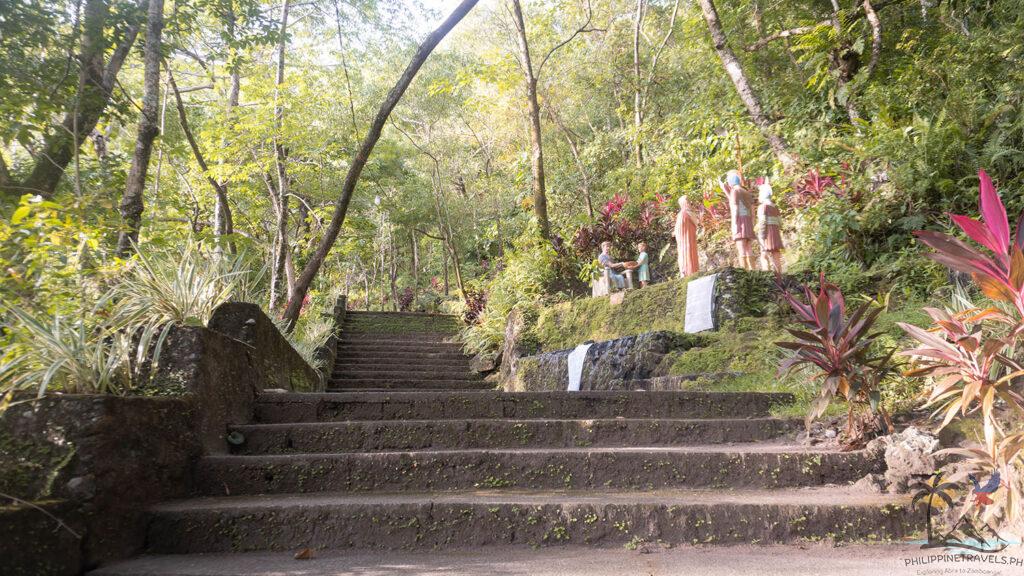
If you’re not short on time, walking up the Walkway to the Old Volcano is well worth it.
It isn’t too tiresome, and you’ll also get very nice views of the Sunken Cemetery below!
Speaking of which…
Sunken Cemetery is one of the most recognizable landmarks in Camiguin.
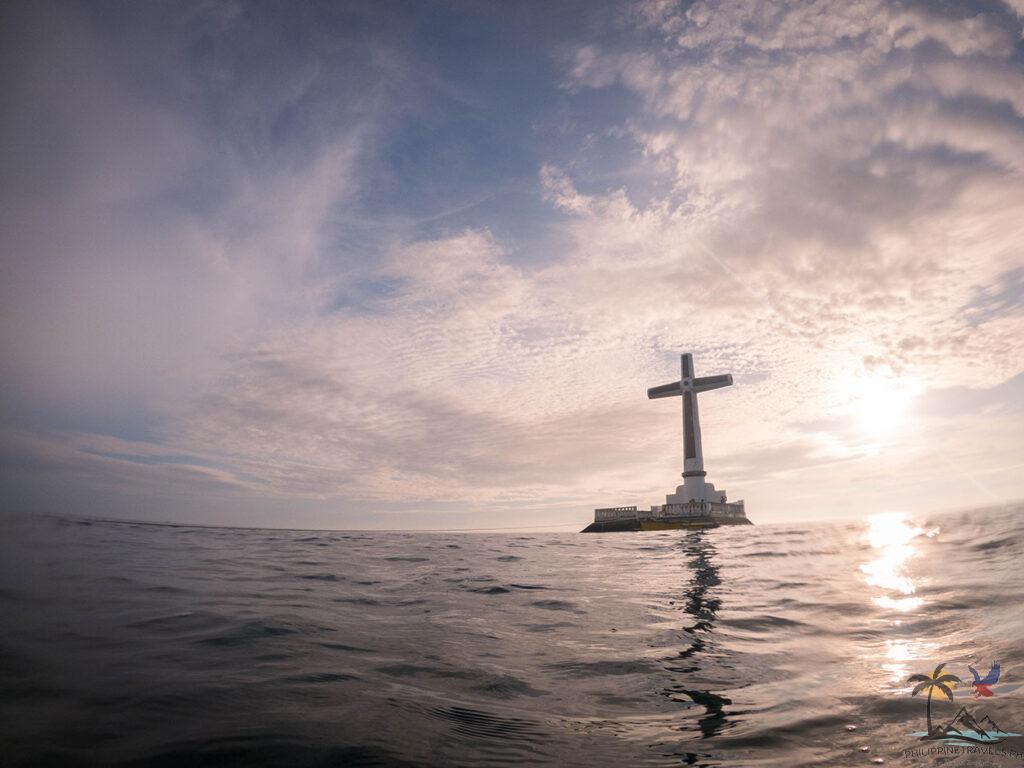
While the cemetery itself is mostly covered in corals nowadays, you can still see the old cross beneath the surface, and this old gravestone and bust too!
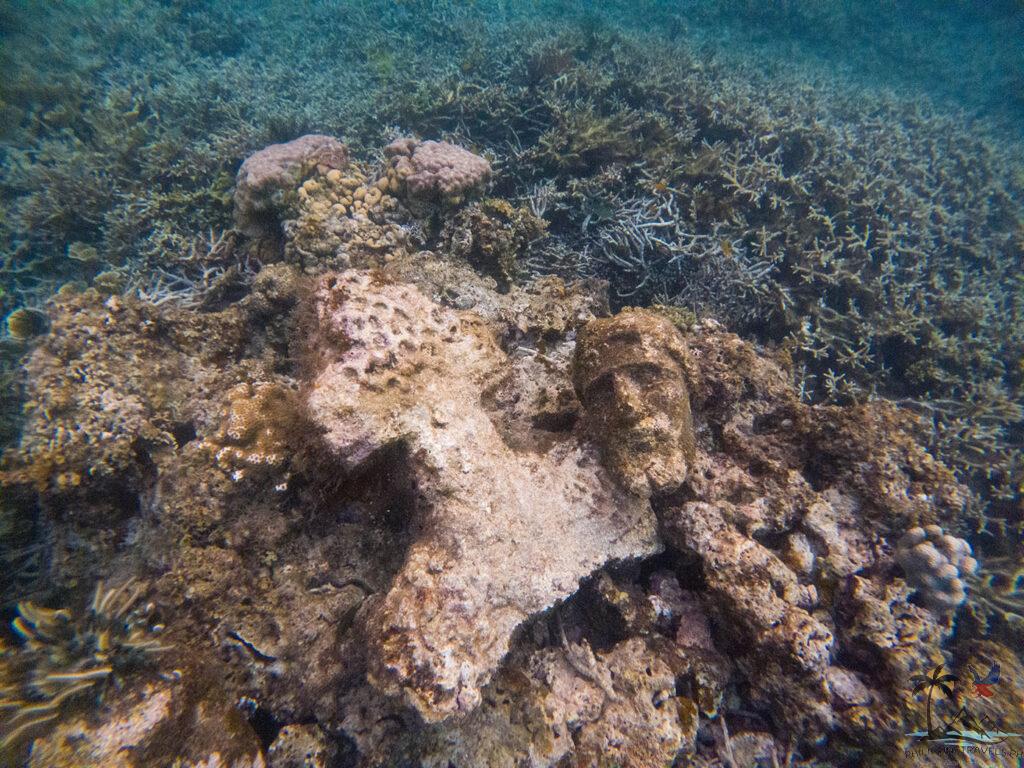
The highlight of visiting Sunken Cemetery though has to be watching the sunset at the giant cross landmark.
Finally, just 500 meters away are the Old Spanish Church Ruins (aka Guiob Church Ruins).
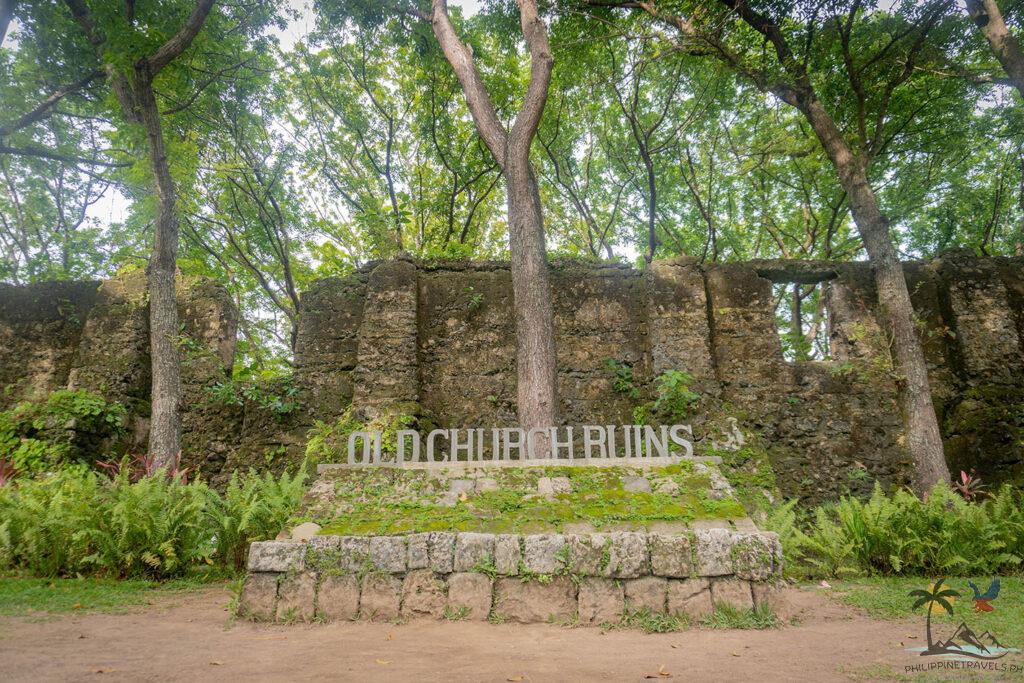
The church didn’t collapse into the sea as the cemetery did, but it certainly took a beating!
If you see the ruins today, you might think it was an old fort. The stone walls along with the beautifully lined up trees might remind of you places like Fort Santiago or Fort San Pedro.
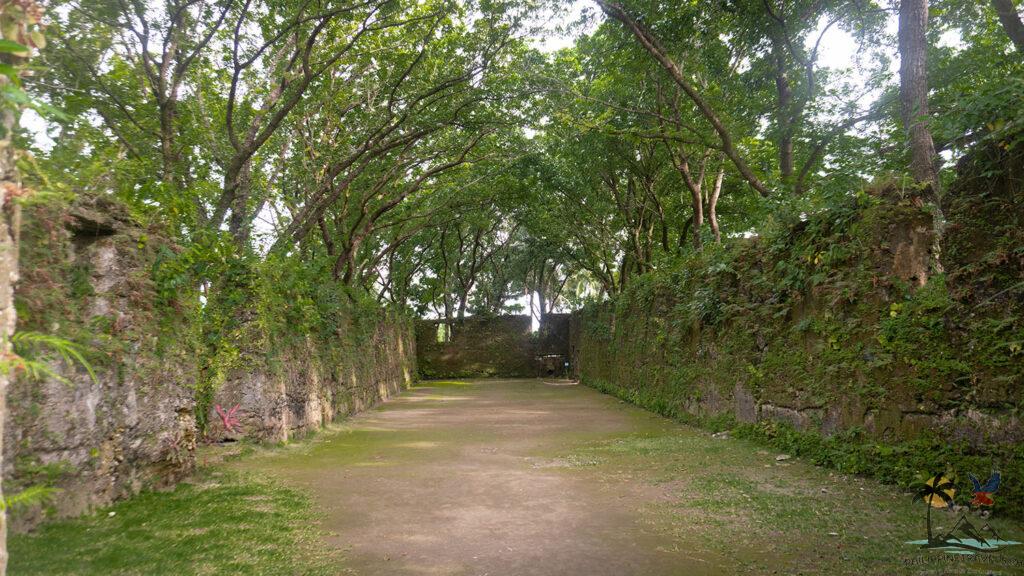
One can only wonder what it looked like when the church was still up!
What to do in Camiguin #3: Take a Dip in Catarman’s Springs and Waterfall

Camiguin is PACKED with cold springs and waterfalls.
And the great thing is, three of these are found pretty close to one another!
Catarman is home to the famous Sto Nino Cold Spring, Tuasan Falls, AND Bura Soda Water Park.
Sto. Nino Cold Spring is my personal favorite. The swimming area is quite large, and the water here is the bluest you’ll ever see.
There are also rocks at the bottom of the spring, making it a great place to get some cool photos.
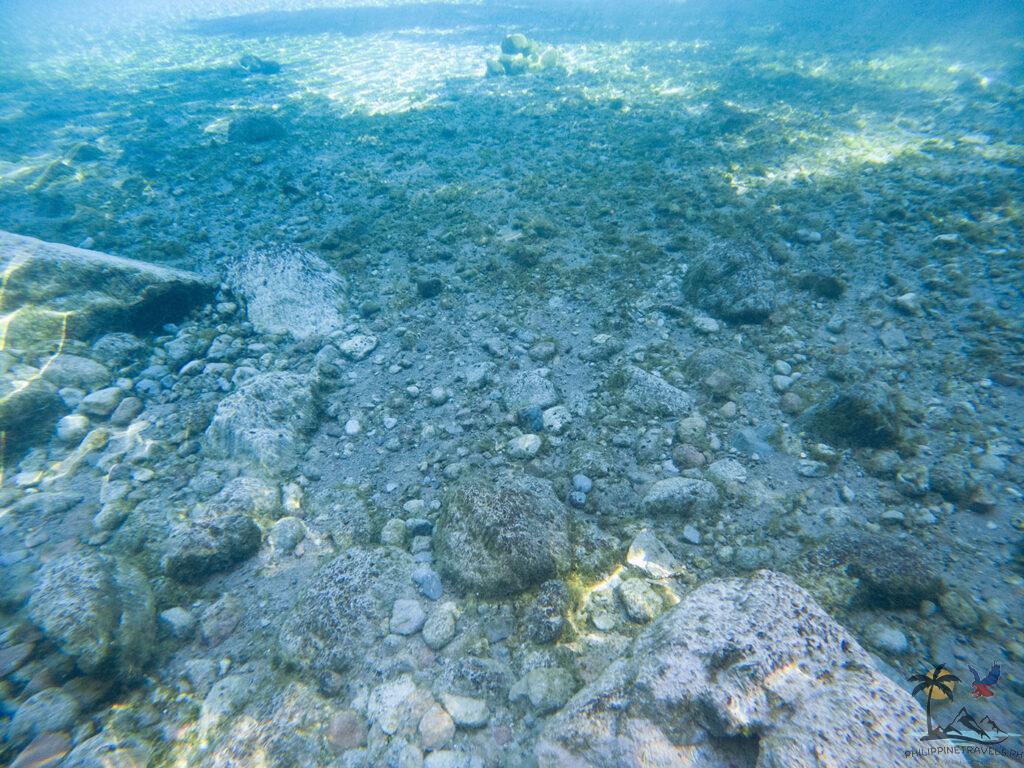
Tuasan Falls isn’t the tallest waterfall in Camiguin (that’s Katibawasan), but it certainly isn’t unimpressive!
The allure of this falls comes from the fact that it’s so isolated.
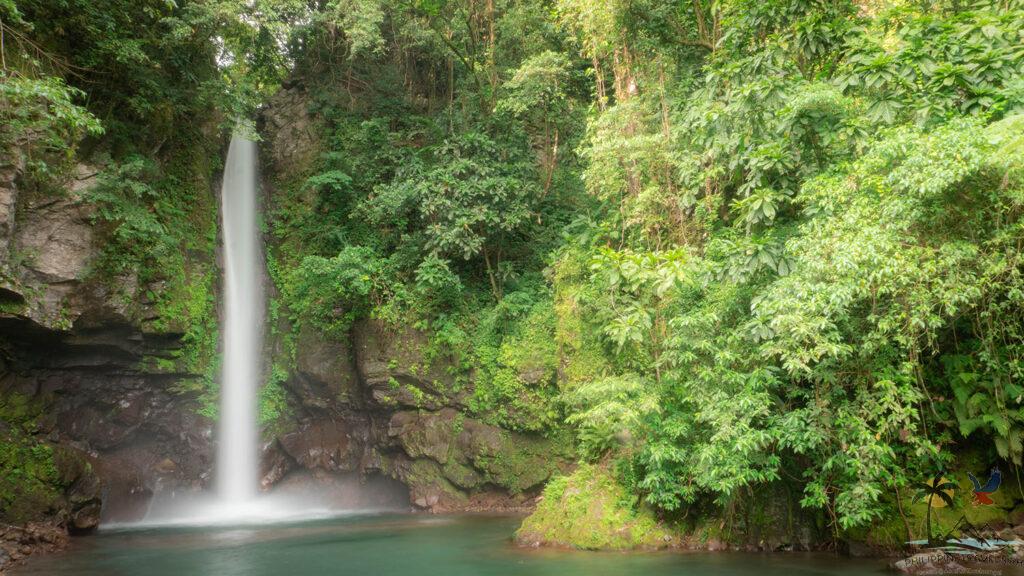
Not isolated in the sense that it’s hard to get there (the road leading up to it is all paved), but in a sense that there’s almost nobody around (especially on weekdays!).
Finally, Bura Soda Water Park.
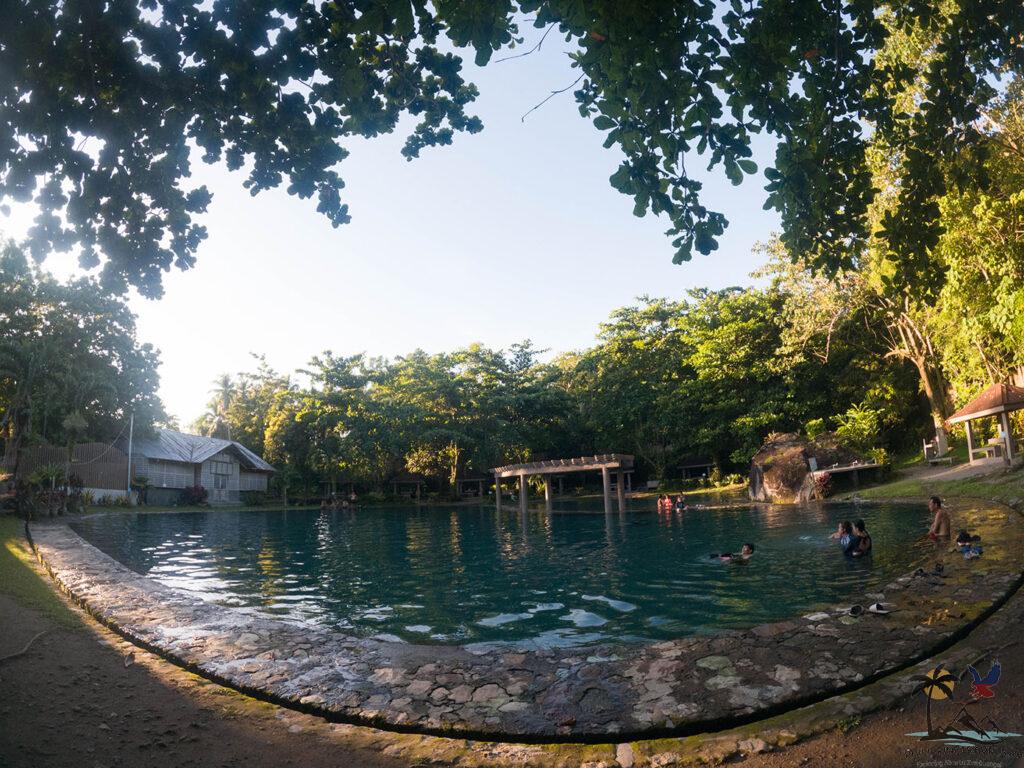
The whole concept of this park is that their water is supposed to taste like soda.
Does it?
Well… not really!
It just tastes like natural spring water.
It’s a fun gimmick though, as there are pipes of flowing water where you can have a drink anytime.
Aside from that, there’s also a swimming area. But in my book, Sto Nino Cold Spring is a step ahead of this one.
What to do in Camiguin #4: Rent a Motorbike and Circumnavigate Camiguin!

The best way to get around Camiguin is by renting a motorbike.
It only costs php400 – 600 ($8 – $12) a day, and it makes getting around SO much easier and more convenient.
So if you’ve got time, why not explore the WHOLE Camiguin?
A trip around the entire island is only going to take about two hours. Plus, you’ll get to see what life on the island is really like.
You can also use this time to visit some lesser-known spots that are along the way.
For example, if you’re starting in Mambajao and driving clockwise around the island, you can have quick stopovers at:
- Taguines Lagoon
- Katunggan Park
- The Moro Watchtower
- Sto. Rosario Church
There’s also this scenic road that juts out into the sea, somewhere between Mambajao and Mahinog (see photo above).
Most of these spots are quite far from the tourist zones, and can be a little out of the way.
That’s why if you’re visiting one of them, why not visit them all and turn around the whole island???
Of course, you could plot your own spots to go and visit. But all in all, riding around the entire Camiguin is a great activity to go for!
What to do in Camiguin #5: Ponder Life at Tongatok Cliff During Sunset

If you wanna go the Camiguin way and take things slow, then watching the sunset at Tongatok Cliff is something you should do!
No, this isn’t the only place you can see the glorious Camiguin sunset, but it’s one of the best ones.
Tongatok Cliff is placed so perfectly.
On your left and right, you’ll see the hills and mountains of Camiguin. Straight ahead, you’ll see the endless sea. Above you is the vast, purple sky. And beneath you the waves crash upon the rocks of the island.
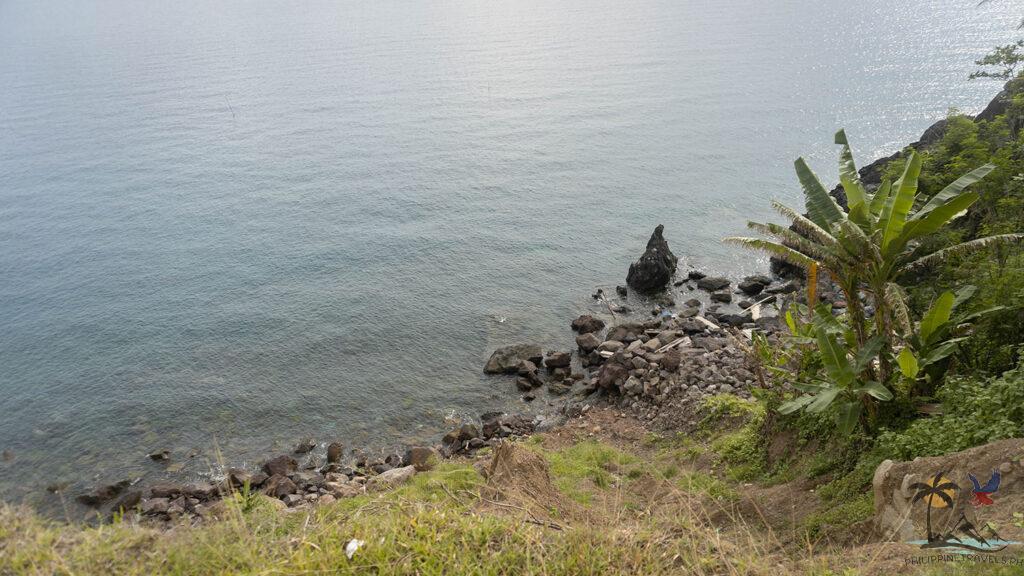
It’s very peaceful and scenic.
Other great places to watch the sunset are Parola Mambajao – where you can see how locals spend their time.
And Sunken Cemetery – which is just a stone’s throw away from Tongatok, but not exactly as peaceful.
What to do in Camiguin #6: Test Your Fitness and Climb Mt. Hibok-Hibok

WARNING:
This is NOT for casuals!
The Camiguin Tourism Office lists Hibok-Hibok as a tourist spot.
While I get their point (Mt. Hibok-Hibok is a magnificent place to visit), I can’t help but feel that mayyyyyybe they should put a warning about how difficult climbing it is.
Expect 4-5 hours of walking up steep slopes, sometimes using your hands to climb.
Expect to be covered by thick forests, full of leeches and plenty of thorns.
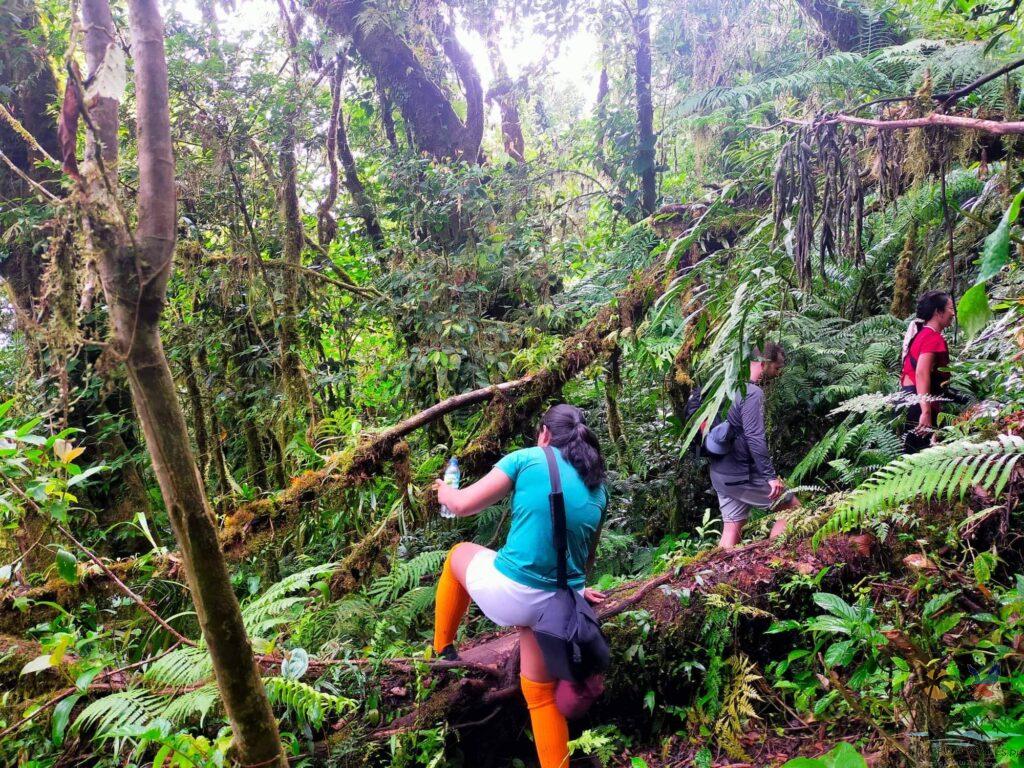
Our guide told us that many people quit halfway, some even in tears.
But I don’t mean to scare you away!
If you’re up for the challenge, this hike will surely be one of the best things you did in Camiguin.
The crater of Hibok-Hibok is a wonderful place to relax before going for the summit. You can even camp here for the night!
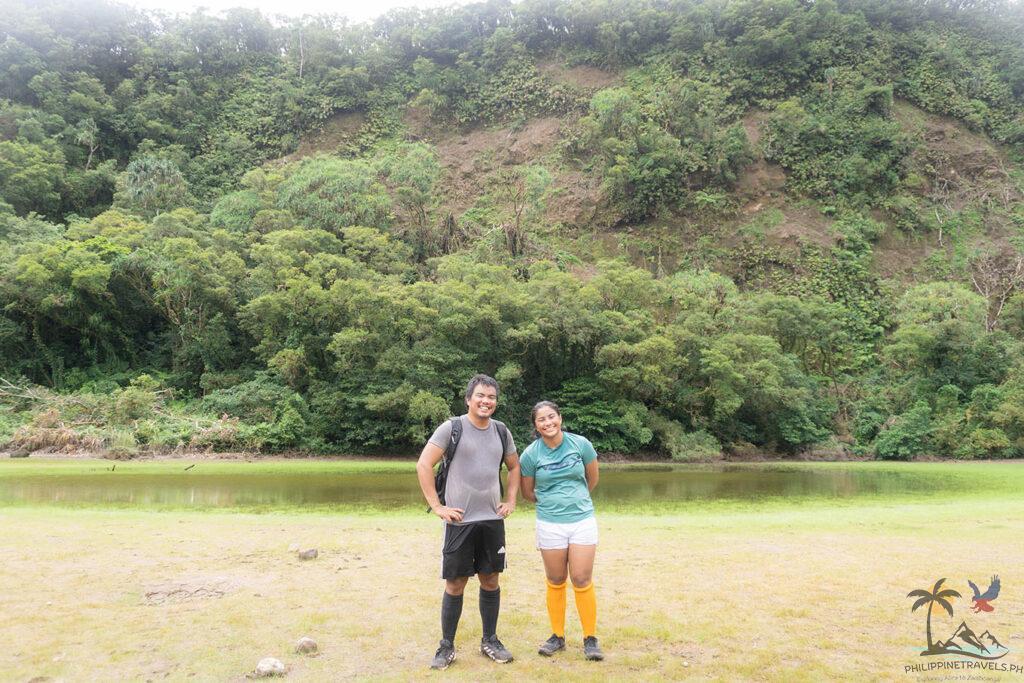
And the summit?
The view from the summit, 1,200 meters above Mambajao, is beautiful.
You can see White Island alllll the way down there. You can also see Bohol to the North, and Surigao to the East.
Unfortunately, when we reached the top, the weather wasn’t cooperating and there was a thick blanket of fog.
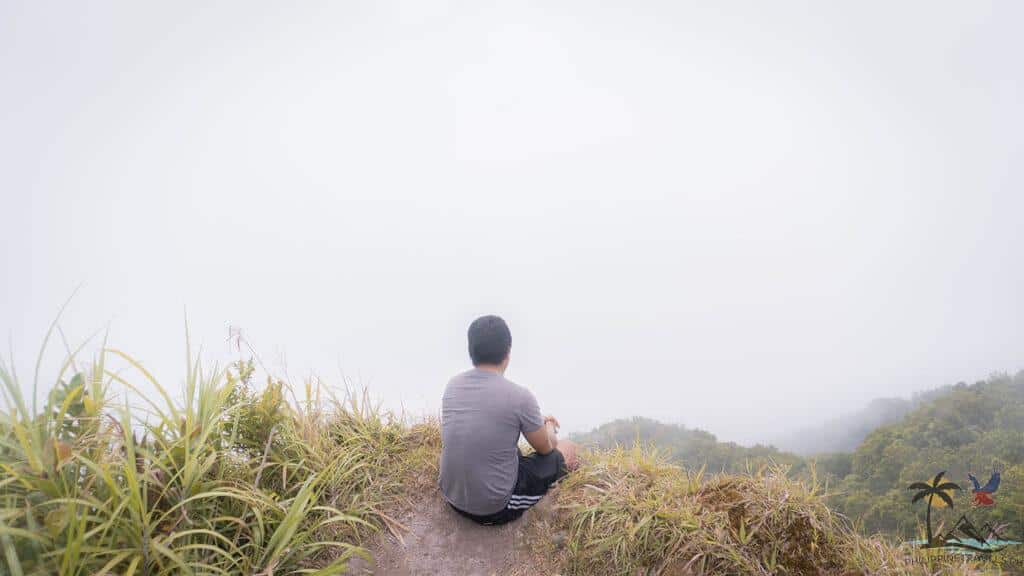
Still a wonderful experience though!
Again, if you wanna read more about each of these activities (and more!) and how to get to them, check out my Camiguin tourist spots article!
What and Where to Eat in Camiguin
There’s no shortage of good food in Camiguin!
The only caveat?
Most restaurants take a longgggggggggg time to serve your food.
But hey!
You’re in Camiguin.
Take it slow!
Here are some of the places we ate when we were there.
Where to Eat in Camiguin #1: Northern Lights – Local Favorite
You know a restaurant is good when you eat there not once, but twice!
Northern Lights has a pretty overwhelming menu. They’ve got everything from pizzas, to everyday Filipino food, and even goat dishes.
If you don’t know where to start, their “ordinary” dishes actually taste great.
We had their fried chicken and their lechon kawali twice because it’s so good.
We didn’t get to try their pizzas, but it does seem to be very popular among locals.
Northern Lights has four branches around the island – two in Mambajao (Balbagon and Agoho), one in Catarman, and on in Mahinog.
The Agoho branch – where we ate – is pretty convenient since it’s in between Mambajao and Catarman.
You can also buy the famous Camiguin ice cream in Northern Lights. Speaking of which:
Where to Eat in Camiguin #2: Moon Flower Garden – Best Ice Cream
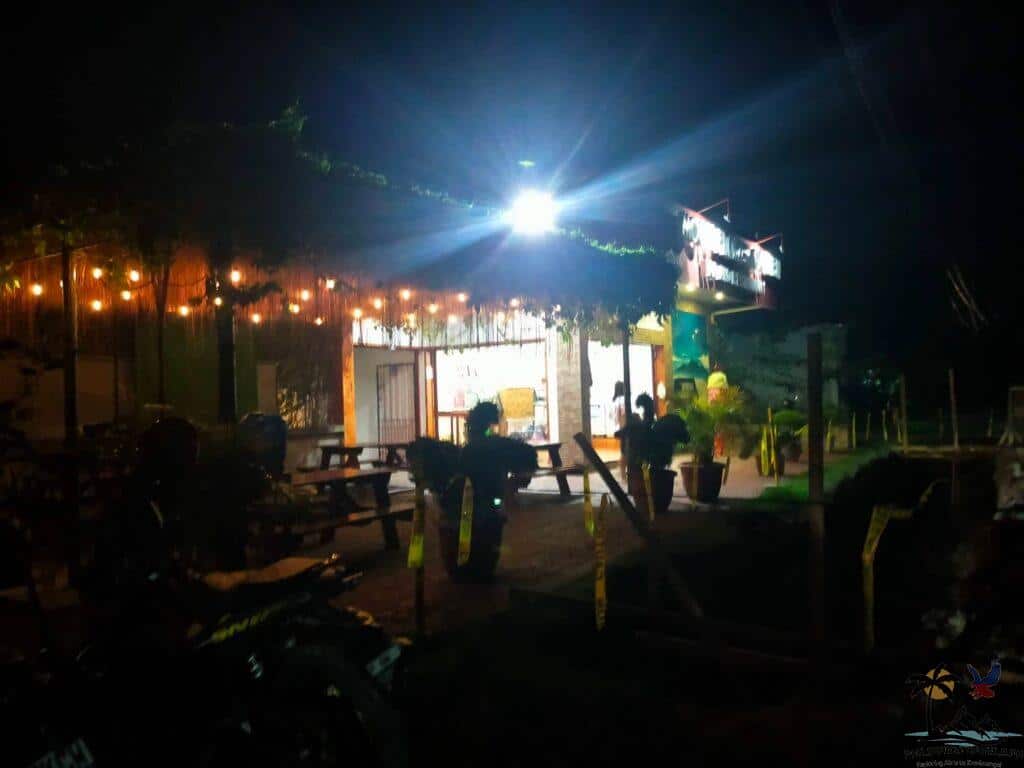
Good homemade ice cream is a miles ahead of mass-produced ice cream.
Right?
Well then you’ll be SUPER happy to know that there’s a reallllly popular homemade ice cream shop in Camiguin.
Moon Flower Garden is a cozy little restaurant that serves a number of local and international dishes – even Japanese fusion dishes.
We didn’t get to try the sushis they had, because ALL we wanted was their ice cream!
And boy was it good.
They have all kinds of flavors including:
- Chocolate
- Strawberry
- Mango
- Ube
- Durian
- Coffee
- Moringa
And more!
Moon Flower garden is found in Baylao, a few minutes away from the airport.
But you can also order their ice creams in the Northern Lights branches!
Where to Eat in Camiguin #3: I 8 See Food – Seafood
As you’re driving towards Mambajao, one restaurant you’ll surely notice is I 8 See Food.
It’s big, it’s pretty bright, but it’s altogether a very cozy restaurant.
They even have a giant tree growing right in the middle of their store.
As you can guess, I 8 See Food specializes in seafood.
Their shrimp dishes are delicious, and their crabs were good too.
And even their non-seafood dishes were awesome.
Where to Eat in Camiguin #4: La Isla Cocina & Paradiso Restaurant – Italian and Spanish

One interesting thing about Camiguin is that there are plenty of Italian restaurants around.
The one we tried was La Isla Cocina & Paradiso Restaurant, found just along the highway to Mambajao.
It’s in a very old Spanish-style house. The interior is beautiful in a classic type of way.
And the food?
The food is great too!
They serve a mix of Spanish and Italian dishes here.
We tried the pizza of course, and it was really tasty!
Where to Eat in Camiguin #5: Tongatok Cliff Resort – Convenient Location
Another place we ate was at the Tongatok Cliff Resort.
The food over here was good – but nothing too memorable.
One thing that this restaurant has though is that it’s literally right there in Tongatok Cliff – where you might be watching the sunset already.
Considering that food in Camiguin takes a LONG time to cook and arrive, you might just decide to eat here instead of driving back to Mambajao.
That’ll save you if you’re starving!
What to Eat in Camiguin #6: Kiping
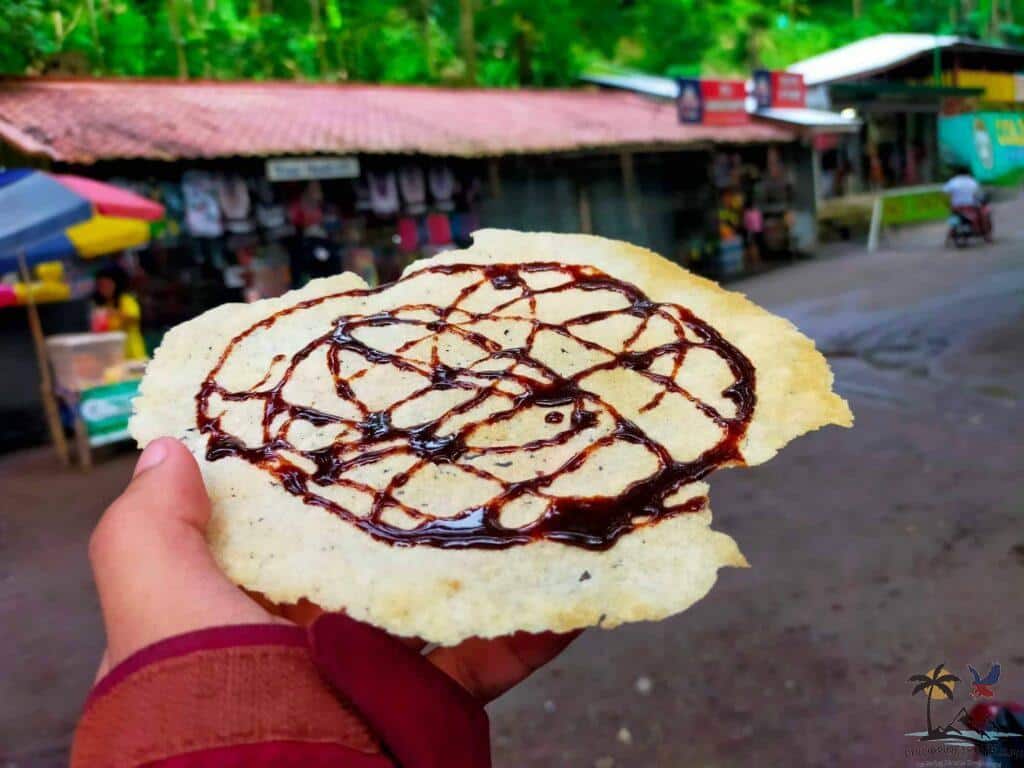
Kiping – a flat cassava crisp drizzled with molasses – is popular all over Camiguin.
You’ll find it for sale outside tourist spots like Sto Nino Cold Spring or Katibawasan Falls.
And you’ll find locals eating it here and there too.
While Kiping isn’t only found in Camiguin, if you’re like me and enjoy trying the foods locals enjoy, then you should definitely try this!
What to Eat in Camiguin #7: Lanzones

Come October, Camiguin plunges into one of the most exciting seasons in this little province:
Lanzones season!
These tasty little fruits are all over the place during this time.
We were even told that during the Lanzones festival, there are boxes of lanzones given away for free!
Sadly, when we visited in June, there were absolutely ZERO lanzones around.
However, there is a pasalubong store along the road where you can get some lanzones flavored delicacies like pastillas, ice cream, and more.
Sample Camiguin Itineraries (+What I Did!)
I made a lot of mistakes with my time in Camiguin.
In hindsight, I could’ve planned much better.
That’s why I’m gonna throw these sample itineraries together for you guys.
Hopefully, you can get more out of your time than I did!
A few notes before we begin: nowadays, all flights arrive at Camiguin at 3pm – meaning your first day is going to be a bit short.
On the same note, all flights leave Camiguin at around 3:30.
If you’re arriving by boat, you can have more (or less!) time then these itineraries suggest!
Sample 3D2N Camiguin Itinerary – All the Best Spots
Day 1: Arrival &Sunken Cemetery
- 3:00pm – Arrive at Camiguin Airport / Check in hotel
- 4:00pm – Snorkel Around Sunken Cemetery
- 5:00pm – Watch sunset at Sunken Cemetery monument
- 6:00pm – Head back to town, eat dinner, go to bead
Day 2: Islands + Springs
- 5:00am – Visit White Island
- 6:00am – Eat breakfast
- 7:00am – Visit Mantigue Island!
- 11:00am – Check out Katibawasan Falls
- 12:00pm – Lunch / Chill (make sure to try Moon Flower ice cream!)
- 2:00pm – Bura Soda Water Park (drink the soda water!)
- 3:00pm – Tuasan Falls
- 4:00pm – Sto. Nino Cold Spring
- 5:30pm – Tongatok Cliff Sunset
- 7:00pm – Dinner, sleep
Day 3: Old Church Ruins + Head Home
- 7:30am – Climb the Walkway to the Old Volcano
- 9:00am – Visit the Old Church Ruins
- 10:00am – Ardent Hot Spring
- 12:00pm – Lunch and Check out
- 3:30pm – Fly Back Home
Sample 4D3N Camiguin Itinerary – Best Spots + Mt. Hibok-Hibok + Motorbike Tour
Day 1: Arrival & Sunken Cemetery
- 3:00pm – Arrive at Camiguin Airport / Check in hotel
- 4:00pm – Snorkel Around Sunken Cemetery
- 5:00pm – Watch sunset at Sunken Cemetery monument
- 6:00pm – Head back to town, eat dinner, go to bead
Day 2: Climb Hibok-Hibok + Katibawasan Falls
- 5:00am – Start Climbing Ht. Hibok-Hibok!
- 8:00am – Reach crater area – eat breakfast
- 9:00am – Mt. Hibok-Hibok Summit!
- 10:00am – Start descent
- 1:00pm – End hike, eat lunch, rest
- 3:00pm – Katibawasan Falls
Day 3: Islands + Roadtrip Around the Whole Camiguin!
- 5:00am – Visit White Island
- 6:00am – Eat breakfast
- 7:00am – Visit Mantigue Island!
- 10:30am – Katunggan Park
- 11:30am – Lunch in Mahinog
- 12:30pm – Continue roadtrip!
- 1:00pm – Moro Watchtower
- 1:30pm – Sto Rosario Church
- 2:30pm – Sto Nino Cold Spring
- 4:00pm – Tuasan Falls
- 4:30pm – Bura Soda Water Park
- 5:30pm – Tongatok Cliff Sunset
Day 3: Old Church Ruins + Head Home
- 7:30am – Climb the Walkway to the Old Volcano
- 9:00am – Visit the Old Church Ruins
- 10:00am – Ardent Hot Spring
- 12:00pm – Lunch and Check out
- 3:30pm – Fly Back Home
What I Did – 7D6N Camiguin Itinerary
Before I begin, keep in mind that this was a work trip!
Me and my sisters spent the mornings and early afternoon working – we didn’t have all day to expore.
Also, there are a LOT of mistakes made in this trip.
We didn’t know almost all the spots close at 5pm, and we were also unaware that the Giant Clam Sanctuary was closed.
But alright, alright. Here’s exactly how I spent my 7 days and 6 nights in Camiguin!
Day 1: Arrival & Sunken Cemetery
- 3:00pm – Arrive at Camiguin Airport / Check in hotel
- 4:00pm – “lunch” at Northern Lights Agoho
- 5:00pm – Snorkel Around Sunken Cemetery (note, we were able to get a guide just as he was going home. To avoid this, please visit Sunken Cemetery earlier than we did!)
- 6:00pm – Head back to town, dinner at I 8 See Food
Day 2: Old Church Ruins + Tuasan Falls + Closed Springs
- Morning – Work
- 3:30pm – Tongatok Cliff
- 4:00pm – Old Church Ruins
- 4:45pm – Tuasan Falls
- 5:15pm – Bura Soda Water Park (but it was CLOSED!)
- 6:00pm – Head back to Mambajao defeated
- 7:00pm – Dinner at Tongatok Cliff Resort
Day 3: Roadtrip Around the Whole Camiguin
- Morning – Work
- 1:00pm – Start roadtrip!
- 2:00pm – Arrive at Giant Clam Sanctuary entrance (but it was CLOSED)
- 2:30pm – Arrive at where Moro Watchtower is supposed to be (but we couldn’t find it!)
- 2:45pm – Stopover at Sto Rosario Church
- 3:00pm – Sto Nino Cold Spring!
- 4:30pm – Bura Soda Water Park
- 5:30pm – Sunset at Tongatok Cliff
- 6:30pm – Dinner at La Isla Cocina & Paradiso Restaurant
Day 4: Island Hopping + Old Volcano
- 6:00am – White Island (to avoid crowds, you should go at 5am)
- 8:00am – Mantigue Island
- 11:00am – Our bike got a flat tire on the way back to Mambajao
- 12:00pm – Lunch at Northern Lights
- Early afternoon – Work
- 4:30pm – Walkway to the Old Volcano
- 6:00pm – Buy Jollibee for hike tomorrow
Day 5: Mount Hibok-Hibok + Katibawasan Falls
- 5:00am – Start climbing Mt. Hibok-Hibok
- 8:00am – Arrive at crater area, rest / eat breakfast
- 10:00am – Hibok-Hibok summit!
- 11:00am – Start descent
- 2:00pm – End Hike
- 4:00pm – Katibawasan Falls
Day 6: Rest + Visit Parks
- Morning and early afternoon – Rest
- 4:00pm – Katunggan Park
- 5:30pm – Parola Mambajao
Day 7: Go Home
- Morning – Work
- 2:00pm – Go home!
Frequently Asked Questions About Traveling Camiguin
Last but not least, let’s answer some of the frequently asked questions about Camiguin!
When is the Best Time to Visit Camiguin?
The best time to visit Camiguin is October, during lanzones season!
I didn’t get to visit Camiguin at this time, but I was told that there are lanzones EVERYWHERE.
Someone even told me that they give away boxes of lanzones for free.
That’s how exciting this time of the year is for the province!
If you can’t make it in October, the other best time would probably be from December to May.
Camiguin is Type IV in the Philippine climate zones, so there’s no pronounced dry season here. Rainfall is evenly distributed all throughout the months.
However, December to May is when the least amount of rainfall usually falls (although, again, this isn’t a pronounced dry season.)
How Many Volcanoes are in Camiguin?
There are 7 volcanoes in Camiguin, namely Mt. Timpoong, Mt. Hibok-Hibok, Mt. Vulcan, Mt. Mambajao, Mt. Tres Marias, Mt. Butay, and Mt. Guinisiliban
Since there are only five towns in Camiguin, that means there are famously more volcanoes than towns in this island!
Of the seven volcanoes, Mt. Vulcan is the easiest and most accessible to climb thanks to the Walkway to the Old Volcano.
Mt. Timpoong is the tallest peak in Camiguin. It’s quite difficult to climb, but it is doable! If you’re interested to climb, you can message Mt. Timpoong and Hibok Hibok’s Facebook page for inquiries (although I’m not sure if Mt. Timpoong is open for tourist activities yet).
One volcano that is surely open for tourists though is Mt. Hibok-Hibok. Rising 1,200 meters into the sky, it’s quite a challenging climb. But as I said above, it’s SUPER worth it!
The rest of the volcanoes aren’t really “tourist spots”.
But hey, if you’re an adventurer, why not ask the locals and give climbing them a shot?
What is Camiguin Known For?
Camiguin is well known for 3 things:
- The Lanzones festival
- For time being slower here, and
- Its absolutely beautiful natural spots
I didn’t get to see the lanzones festival, but I’m told that it is crazzzzzzy. Hopefully, I can go and see it for myself someday!
As for time being slow, it’s something that you’ll feel the moment you arrive in Camiguin.
The cars move so much slower than what I’m used to in cities.
On such a small island with such small communities, who needs to rush?
How Big is Camiguin Island?
Camiguin is 229.8 square kilometers. It’s around 60 kilometers in circumference. And driving around the entire island will take you about 2 hours.
It is the second smallest province (after Batanes), and the second least populated too (again, after Batanes).
All of this really adds to its charm though.
If you take things slow, you’ll really get to appreciate the smallness of this province.
Is Camiguin Safe?
Yes! If you’re from outside the Philippines, don’t let the fact that Camiguin is in Mindanao scare you. This is one of the safest places in the Philippines for tourists.
In fact, I felt a LOT safer here than when I was traveling to other parts of the country.
It’s one of the places where you can leave your helmet on your motorbike – and be sure that even after a couple of hours, no one will take it (in places like Cebu City, you HAVE to lock your helmet or you can say goodbye to it).
One of the reasons for this is that Camiguin is a small island with small communities. People know each other here, which is always a crime deterrent.
There’s also a visible police force, which almost felt unnecessary. But hey, they’re there if you need them!
Of course, there are always a few bad eggs, even in places like this. So don’t be irresponsible.
But if you had any doubts about coming here for safety reasons, throw those away!
Camiguin is a VERY safe place to visit!
What is the Isle Visit Camiguin QR?
Isle Visit Camiguin is a QR code all tourists need to get to enter Camiguin. It’s what the Camiguin Tourism Office uses to track how many visitors they get, and which spots are the most popular.
Isle Visit Camiguin replaced the Clean Camiguin QR system in 2024. Clean Camiguin QRs were first implemented during the pandemic. You can still use your Clean Camiguin details to login to the new Isle Visit Camiguin website.
The tourism office plans to implement online booking systems for their tourist sites using the Isle Visit Camiguin system. It’s unclear how they plan to do this, but I’m excited to see it!
Maybe Camiguin will be the front runner for a new tech side of tourism in the Philippines?
Ready to Visit Camiguin???
That’s everything you need to know before visiting Camiguin!
I really hope my Camiguin travel guide has helped you, or, at the very least, made you even MORE excited to go and visit!
Camiguin is EASILY one of my favorite provinces in the country.
I still have a lot more to visit, but I already know that even after seeing all 81, Camiguin is still going to be up there with the very best ones.
So go.
Plan your Camiguin trip.
And enjoy the Land Born of FIRE!
(Have any comments or questions? Leave them down below and I’ll get back to you! And don’t forget to read my 18 Favorite Camiguin Tourist Spots!)

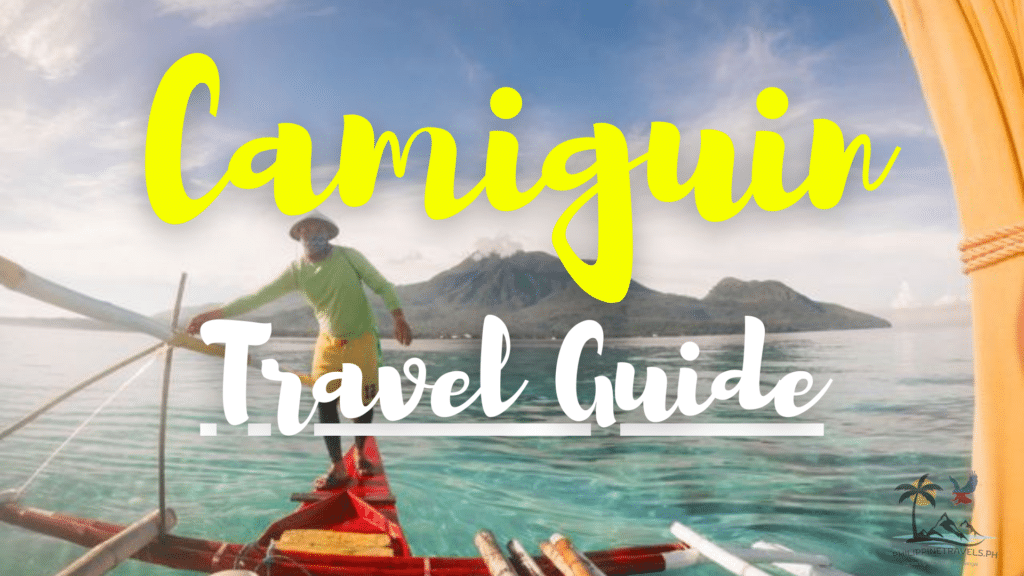
Hello, may i ask about going to white island how to get there po? You rent a small boat?
Yup!
They have a system for renting a boat there so no need to haggle or anything.
I wrote a full guide about it here: https://philippinetravels.ph/white-island
Cheers!
Thanks for this detailed travel guide. Will visit Camiguin next year and will surely keep your guide in mind.
Enjoy! 🙂
May I know how you reached out to these boatmen / tour guide through out your trip? do you have their contact information? Thank you!
For White Island and Mantigue?
You don’t need to contact them ahead.
You can just go the White Island Ferry Terminal for White Island, and the Mantigue Island Departure Area for Mantigue, and there’ll be lots of boatmen waiting there. 🙂